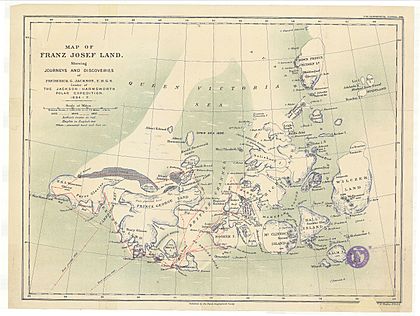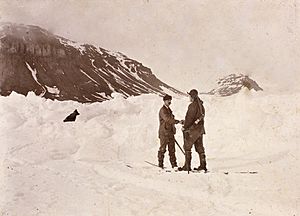Jackson–Harmsworth expedition facts for kids
The Jackson–Harmsworth expedition was an exciting journey to the Arctic from 1894 to 1897. It explored Franz Josef Land, a group of islands far to the north. British explorer Frederick George Jackson led the trip. A newspaper owner named Alfred Harmsworth paid for it.
Jackson first thought Franz Josef Land was a huge landmass reaching the North Pole. But the expedition's main job was to map the area. They discovered it was actually an archipelago, which is a group of islands. The northernmost island did not go past 82 degrees North.
Contents
Meet the Expedition Team
The Jackson–Harmsworth expedition had a small but dedicated team. Each person had an important role to play.
Here are some of the key members:
- Frederick George Jackson, the leader of the expedition.
- Albert Armitage, who studied the stars and weather.
- Reginald Koettlitz, the doctor and rock expert.
- J.F. Child, who looked for minerals.
- Harry Fisher, a plant and animal expert. He was later replaced by William Speirs Bruce.
- Blomkvist, who was originally part of the ship's crew.
- Sidney Burgess, who worked as the cook.
- Wm. Hayward, who later took over cooking duties.
- David Wilton, a biologist who was in charge of the dogs.
The Arctic Voyage
Setting Sail in 1894
The expedition's ship was called the Windward. It was a strong whaling ship from Peterhead, built to handle ice. It also had a steam engine. On July 12, 1894, the Windward left Greenhithe, England.
The ship first sailed to Arkhangelsk in Russia. Here, they loaded important supplies. These included ponies from Siberia and warm fur outfits from the Samoyed people. Next, they went to Khabarovo. They took on 30 Siberian dogs there.
The Windward then sailed through the icy Arctic Ocean. It finally reached Franz Josef Land on September 7. This was their first discovery, an island they named Windward Island.
Jackson decided to set up their main camp at Cape Flora. They built two log houses, an observatory, and four storage buildings. They named their settlement Elmwood. This was to honor Alfred Harmsworth, whose home in Kent was also called Elmwood.
The original plan was for the Windward to return to England for the winter. But the sea ice returned too quickly. This meant the ship and its crew had to stay for the winter too. The men kept active during the cold months. They played football and hockey games. They also hunted bears for food. Sadly, one crew member became very sick and passed away during the winter. This was due to scurvy, a disease caused by not eating enough fresh food.
Exploring in 1895
On March 10, 1895, Jackson, Armitage, and Blomkvist began a journey north. They used two ponies and four sledges. Their goal was to set up supply points, called depôts, along their route.
Their second journey started on April 16. Koettlitz and Heyward joined them, along with another pony and two more sledges. The melting ice made travel very difficult. The ponies sometimes broke through the ice and had to be pulled out. They followed their old path to Peter Head. Then they continued northeast to Dundee Point. From there, they went north to the west coast of Jackson Island. They set up more supply points as they went.
This journey helped them understand the land better. They realized that Zichy Land was not one big landmass. Instead, it was a group of separate islands.
On July 11, Jackson, Armitage, Fisher, Child, Blomkvist, and Koettlitz set out in a whaleboat. The boat was named Mary Harmsworth. They wanted to map the area to the northwest. They reached and climbed Cape Grant, Cape Crowther, and Cape Neale. From these spots, they discovered and named Cape Fridtjof Nansen. These capes were all along the western coast of Prince George Land.
They then sailed around Cape Ludlow and Lofley of Alexandra Land. Here, they found Cape Mary Harmsworth, which is its westernmost point. Before they could reach it, a snowstorm hit the Mary Harmsworth. The storm lasted several days and blew the boat far from land. When the wind changed, they were able to sail back to Cape Grant. After fixing the boat and waiting out another six-day storm in a tent, they returned to Elmwood. They arrived just before the sea ice would have made boat travel impossible.
Discoveries in 1896
On March 18, 1896, Jackson, Armitage, and Blomkvist started another sledge journey. They had one pony and 16 dogs. They added Koettlitz Island to their map. Then they reached and climbed Cape Richthofen on the west coast of what is now called Luigi Island.
From there, they saw the huge Queen Victoria Sea to the north. The dark sky above the water suggested open water, not land. Jackson finally realized what he had thought the year before. Franz Josef Land did not extend far north. Instead, there was a large area of open water that sledges could not cross.
Realizing that further exploration north was pointless, the group returned. They traveled via Allen Young Sound. Along the way, they sighted and named several islands. These included Nansen, Wilton, Bromwhich, Jeaffreson, Royal Society, and Scott-Keltie Island.
A very surprising event happened on June 17, 1896. Jackson was startled by a tall man with a soft hat, loose clothes, and long hair and beard. This man turned out to be Fridtjof Nansen! Nansen and his friend Hjalmar Johansen had been living on the ice. They had left their ship, Fram, on March 14, 1895. It was pure luck that Nansen and Johansen found the Jackson–Harmsworth expedition camp.
After hearing Nansen's story, Jackson thought about trying to reach the North Pole himself. He even started building copies of Nansen's sledges and kayaks. However, Jackson's team did not have enough experience with skiing and ice travel. So, these plans were quickly stopped.
Final Explorations in 1897
In March 1897, Jackson and Armitage went on a sledge expedition. They had their last horse and 13 dogs. They followed the British Channel to the northeast edge of Prince George Land. There, they discovered Arthur Island. They then traveled along the northern, glacier-covered shore of Alexandra Land to Cape Mary Harmsworth in the far west. From there, they headed back to Elmwood.
The weather during this trip was extremely bad. The pony and all but five of the dogs died. This meant they had to leave behind a lot of their equipment and food. On June 5, they reached Eira Lodge on Bell Island. This was a storehouse built by Benjamin Leigh Smith's expedition in 1881. Here, Koettlitz, Bruce, and Wilton met them. They had brought a sledge full of supplies.
They tried one last time to ski to the area of Brady Island to map it. But they had to stop because their sledge broke through the unstable ice.
The Windward ship arrived in July. It took the expedition members aboard. Before bringing them back to London, they sailed around Cape Mary Harmsworth. This allowed them to study the area beyond it.




